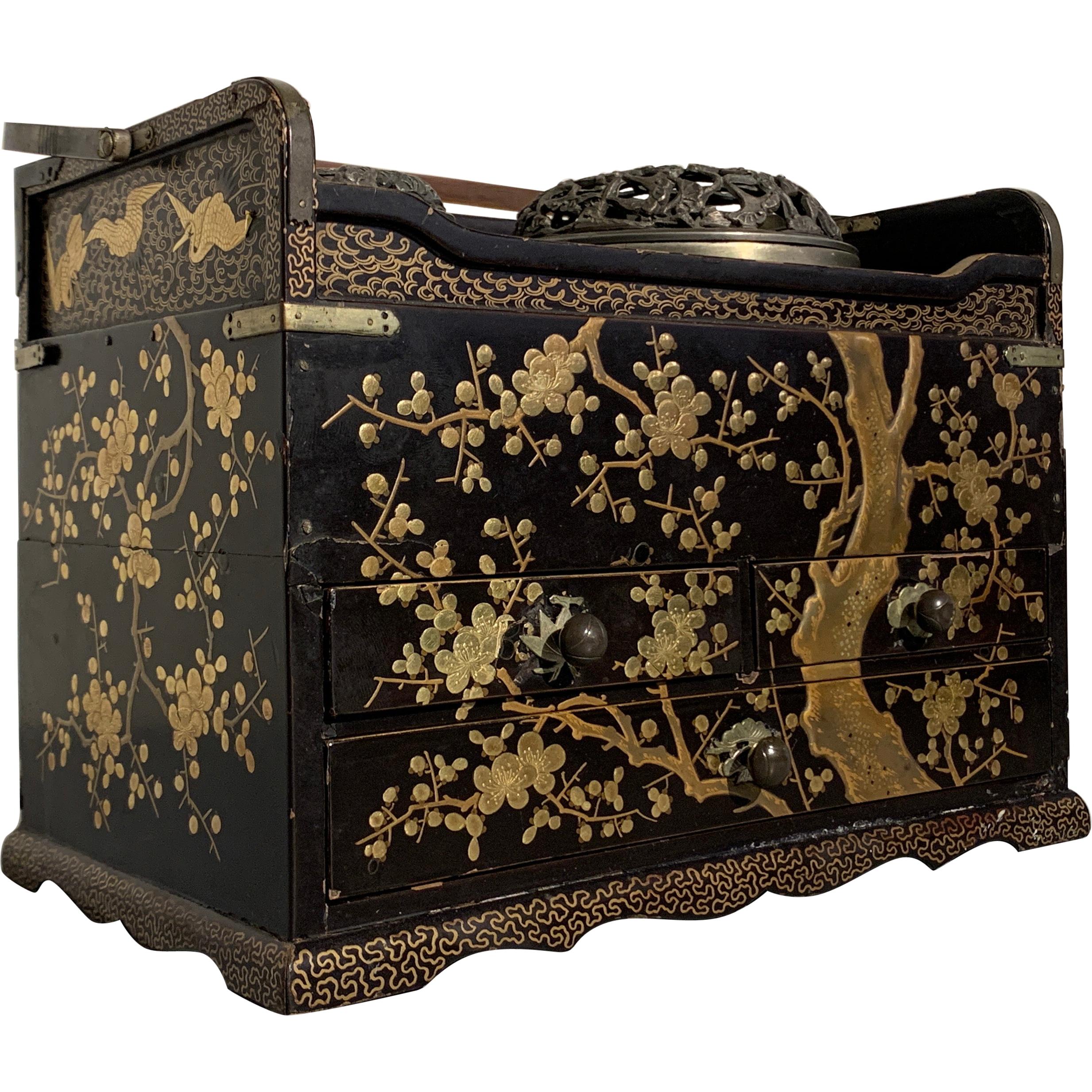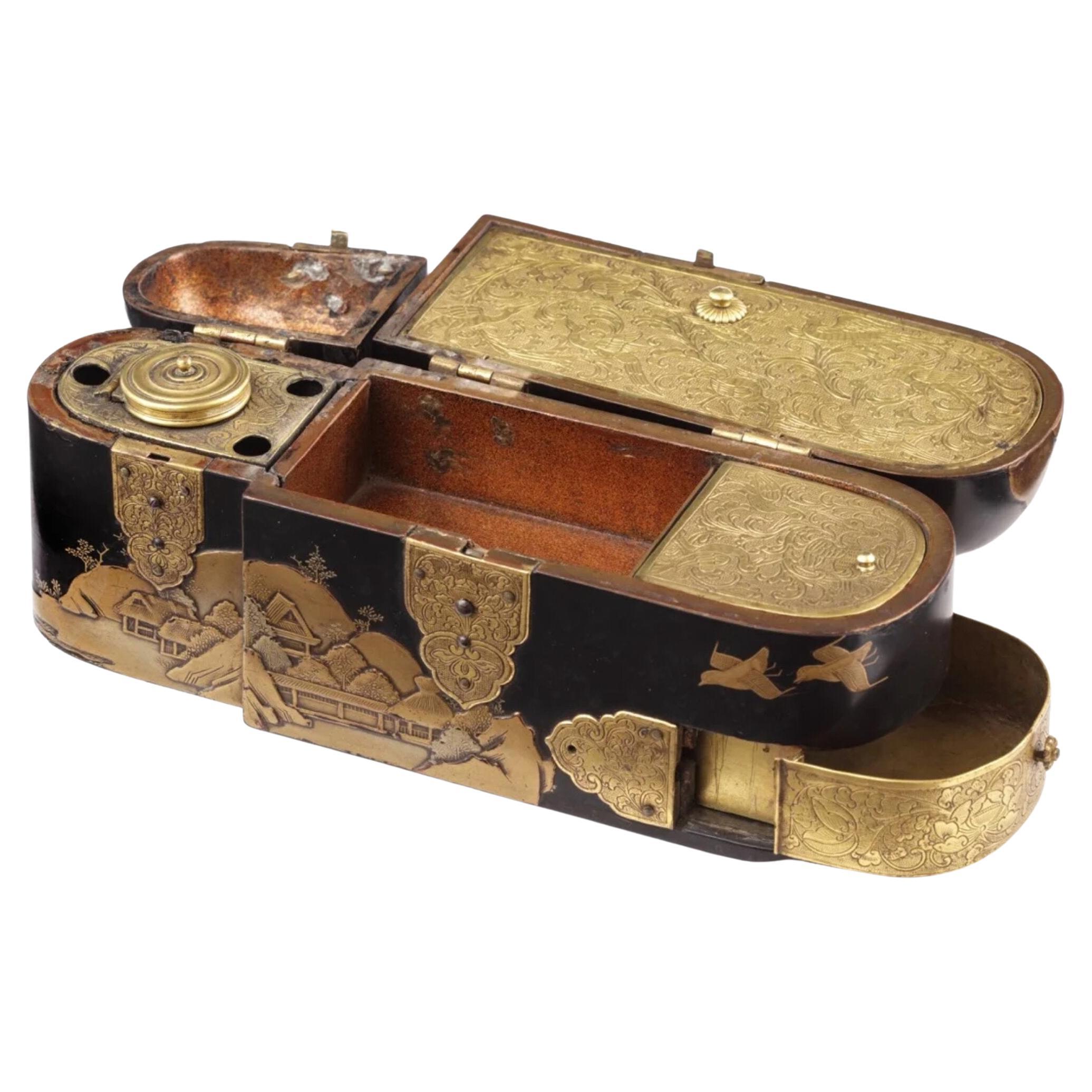Items Similar to Burmese Buddhism Scripture with Lacquer Covers
Want more images or videos?
Request additional images or videos from the seller
1 of 10
Burmese Buddhism Scripture with Lacquer Covers
About the Item
A large Theravada Buddhism scripture book from Burma, circa late 19th century-early 20th century. The book opens to continuous folding pages that is accordion like. Ink scriptures in curvy Burmese language were handwritten on both sides of the pages. The papers are bind by two lacquered wood covers with elaborate design that features relief scrolls and mini mosaic mirrors inlays.
- Dimensions:Height: 3.5 in (8.89 cm)Width: 17 in (43.18 cm)Depth: 7 in (17.78 cm)
- Style:Other (Of the Period)
- Materials and Techniques:
- Place of Origin:
- Period:
- Date of Manufacture:Turn of the 20th Century
- Condition:Wear consistent with age and use. Minor losses. Minor fading. Antique book condition with ink handwriting, expecting paper yellowing, minor stains and general wear on the lacquer cover as shown.
- Seller Location:Atlanta, GA
- Reference Number:1stDibs: LU945020025622
About the Seller
5.0
Platinum Seller
These expertly vetted sellers are 1stDibs' most experienced sellers and are rated highest by our customers.
Established in 2006
1stDibs seller since 2010
479 sales on 1stDibs
Typical response time: <1 hour
- ShippingRetrieving quote...Ships From: Atlanta, GA
- Return PolicyThis item cannot be returned.
More From This SellerView All
- Early 20th Century Burmese Lacquered Tray, “Pagan Bya”Located in Atlanta, GABurmese (Myanmar) Lacquerware has a long tradition dating back to the 13th century. Lacquer in Burma is called “Thitsi” meaning the sap of a Thitsi Tree (Melanhorrea Usitata). Typica...Category
Early 20th Century Burmese Lacquer
MaterialsBamboo, Lacquer
- Early 20th Century Burmese Lacquered Tray, “Pagan Bya”Located in Atlanta, GABurmese (Myanmar) Lacquerware has a long tradition dating back to the 13th century. Lacquer in Burma is called “Thitsi” meaning the sap of a Thitsi Tree (Melanhorrea Usitata). Typica...Category
Early 20th Century Burmese Lacquer
MaterialsBamboo, Lacquer
- Early 20th Century Burmese Lacquered Tray Stand, “Dang lan”Located in Atlanta, GABurmese (Myanmar) lacquer ware has a long tradition dating back to the 13th century. Lacquer in Burma is called “Thitsi” meaning the sap of a Thitsi Tree (Melanhorrea Usitata). Typic...Category
Mid-20th Century Burmese Lacquer
MaterialsBamboo, Lacquer
- Early 20th Century Burmese Lacquer Offering Vessel, Hsun OkLocated in Atlanta, GABurmese (Myanmar) lacquer ware has a long tradition dating back to the 13th century. Lacquer in Burma is called “Thitsi” meaning the sap of a Thitsi Tree (Melanhorrea Usitata). Typically, bamboo and wood are used as a frame or base in making lacquer work. This covered offering vessel is called a “Hsun Ok...Category
Vintage 1920s Burmese Lacquer
MaterialsWood, Lacquer
- Red and Gold Lacquer Portable Tea Bucket and Cover Ryukyu Kingdom OkinawaLocated in Atlanta, GAA rare and complete set of wood bucket with cinnabar lacquer and gold paint housing a pewter tea pot with a fabric pouch from Ryukyu Kingdom, Second Shō dynasty, circa 19th century. Located in nowadays Okinawa Prefecture, Japan. Ryukyu kingdom (1429 to 1879) was a tributary state of imperial Ming...Category
Antique 19th Century Japanese Edo Lacquer
MaterialsPewter
- Fine Miniature Japanese Kodansu with Lacquer InlaysLocated in Atlanta, GAA fine Japanese miniature kodansu constructed from Kaki wood (Persimmon) circa 19th century, late Meiji period. With its expressive exotic wood grains and exposed tenon construction,...Category
Antique Late 19th Century Japanese Meiji Lacquer
MaterialsWood
You May Also Like
- Japanese Export Nagasaki Lacquer Box with the Portrait of Napoleon BonaparteLocated in Amsterdam, NLA Japanese export Nagasaki lacquer tobacco box with the portrait of Napoleon Bonaparte Edo-period, circa 1810 The box in black lacquer on copper, ...Category
Antique 19th Century Japanese Edo Lacquer
MaterialsCopper, Gold
- Burmese Kammavaca Giltwood Box, Stand, and Manuscript, 18th/19th CenturyLocated in Austin, TXA gorgeous Burmese carved and gold leafed teakwood stand and cover for a kammavaca manuscript, late 18th or early 19th century, Burma. The manuscript chest is heavily rococo influenced, speaking to the French presence in the region at the time. The carved teak stand is formed as a raised platform set upon four large scrolling acanthus leaf feet, with carved flour-de-lis to the apron. The cover for the stand is also carved from teak, and features a series of rectangular cartouches, each set with a red foil backed glass "gem", surrounded by shell inlay, and embellished with green and silver foil backed glass sequins. The top of the cover features the same design motif, with the addition of thayo lacquer design elements, and is strongly reminiscent of Tibetan manuscript...Category
Antique Early 19th Century Burmese Rococo Lacquer
MaterialsGold Leaf, Foil, Silver Leaf
- Japanese Lacquer Smoking Box, Tabako Bon, Edo Period, 19th CenturyLocated in Austin, TXA very fine Japanese maki-e lacquer decorated tabako bon, or smoking box, late Edo Period, mid-19th century, Japan. The elegant smoking box of black lacquer decorated with a wonderful gold lacquer takamaki-e design of a gnarled and elegantly twisted plum tree with branches in full bloom. A border of golden cranes in flight to the top. The smoking box, called a tabako bon, is comprised of an open section at the top with inset with two cylindrical metal canisters...Category
Antique Mid-19th Century Japanese Edo Lacquer
MaterialsLacquer
- Rare 17th Century Japanese Export Lacquer Medical Instrument BoxLocated in Amsterdam, NLA rare Japanese export lacquer medical instrument box Edo-period, 1650-1700 L. 19 x W. 6 x H. 8.5 cm This unconventionally shaped lacquer b...Category
Antique 17th Century Japanese Edo Lacquer
MaterialsGold
- A Very Fine Takamaki-e Lacquer Cheroot Case in the Manner of Shibata ZeshinBy Shibata ZeshinLocated in Ottawa, OntarioThe 'ishime' lacquered case consisting of two conforming molded sections with one sliding overtop the other, both sides decorated with hand painted gilt, silver & burnt dark russet (kasshoku) lacquers, depicting motifs in low relief of a rat with an acorn on one side and two acorns on the opposing. In Japanese culture rats are considered auspicious symbols of fertility & wealth, acorns symbolize prosperity & growth. Signed with characters and a mon on one edge. Takamaki-e is a lacquer technique in which metallic powders such as silver, gold, copper, pewter etc., are used in combination with lacquer & clay-dust to build up motifs in low relief. Please note that the color tones & hues of the lacquered motifs appear somewhat more vibrant in the images due to ambient lighting conditions. Regarding the opinion stating the superior quality of this fine example being likened to works associated with those by Shibata...Category
Antique 1870s Japanese Meiji Lacquer
MaterialsLacquer
- Antique Chinese Coromandel Black Lacquer Screen with White Mother of PearlLocated in Toronto, ONThis antique Chinese screen features intricate inlaid mother of pearl goddesses. What makes this screen unusual is the grand scale of the design of the figures. The screen is lacquered in black and entirely hand painted. The reverse side of the screen is also hand painted. The screen can be used as a room divider or headboard. Coromandel lacquer screens...Category
Early 20th Century Chinese Lacquer
MaterialsMother-of-Pearl, Lacquer, Wood
Recently Viewed
View AllMore Ways To Browse
Black Lacquer Furniture
Black Lacquered Furniture
Century Black Lacquer Furniture
Century Furniture Black Lacquer
Antique Cover
Antique Covers
Antique Furniture Covers
Lacquer On Wood
Black Lacquer Design
Black Lacquer Art
Black Lacquer Sides
Paper Covered Furniture
Lacquered Wood Mirror
Black Lacquered Mirrors
Black Lacquer Mirror
Antique Book Open
Antique Book Cover
Antique Book Covers





